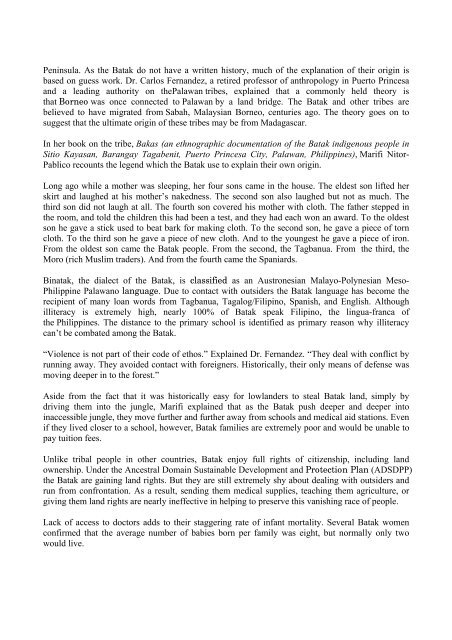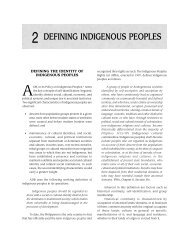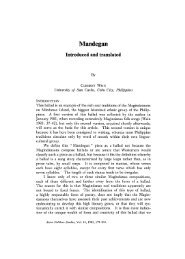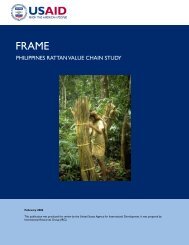The Vanishing Batak Tribe - Ethnic Filipinos, Indigenous & Tribal ...
The Vanishing Batak Tribe - Ethnic Filipinos, Indigenous & Tribal ...
The Vanishing Batak Tribe - Ethnic Filipinos, Indigenous & Tribal ...
Create successful ePaper yourself
Turn your PDF publications into a flip-book with our unique Google optimized e-Paper software.
Peninsula. As the <strong>Batak</strong> do not have a written history, much of the explanation of their origin isbased on guess work. Dr. Carlos Fernandez, a retired professor of anthropology in Puerto Princesaand a leading authority on thePalawan tribes, explained that a commonly held theory isthat Borneo was once connected to Palawan by a land bridge. <strong>The</strong> <strong>Batak</strong> and other tribes arebelieved to have migrated from Sabah, Malaysian Borneo, centuries ago. <strong>The</strong> theory goes on tosuggest that the ultimate origin of these tribes may be from Madagascar.In her book on the tribe, Bakas (an ethnographic documentation of the <strong>Batak</strong> indigenous people inSitio Kayasan, Barangay Tagabenit, Puerto Princesa City, Palawan, Philippines), Marifi Nitor-Pablico recounts the legend which the <strong>Batak</strong> use to explain their own origin.Long ago while a mother was sleeping, her four sons came in the house. <strong>The</strong> eldest son lifted herskirt and laughed at his mother’s nakedness. <strong>The</strong> second son also laughed but not as much. <strong>The</strong>third son did not laugh at all. <strong>The</strong> fourth son covered his mother with cloth. <strong>The</strong> father stepped inthe room, and told the children this had been a test, and they had each won an award. To the oldestson he gave a stick used to beat bark for making cloth. To the second son, he gave a piece of torncloth. To the third son he gave a piece of new cloth. And to the youngest he gave a piece of iron.From the oldest son came the <strong>Batak</strong> people. From the second, the Tagbanua. From the third, theMoro (rich Muslim traders). And from the fourth came the Spaniards.Binatak, the dialect of the <strong>Batak</strong>, is classified as an Austronesian Malayo-Polynesian Meso-Philippine Palawano language. Due to contact with outsiders the <strong>Batak</strong> language has become therecipient of many loan words from Tagbanua, Tagalog/Filipino, Spanish, and English. Althoughilliteracy is extremely high, nearly 100% of <strong>Batak</strong> speak Filipino, the lingua-franca ofthe Philippines. <strong>The</strong> distance to the primary school is identified as primary reason why illiteracycan’t be combated among the <strong>Batak</strong>.“Violence is not part of their code of ethos.” Explained Dr. Fernandez. “<strong>The</strong>y deal with conflict byrunning away. <strong>The</strong>y avoided contact with foreigners. Historically, their only means of defense wasmoving deeper in to the forest.”Aside from the fact that it was historically easy for lowlanders to steal <strong>Batak</strong> land, simply bydriving them into the jungle, Marifi explained that as the <strong>Batak</strong> push deeper and deeper intoinaccessible jungle, they move further and further away from schools and medical aid stations. Evenif they lived closer to a school, however, <strong>Batak</strong> families are extremely poor and would be unable topay tuition fees.Unlike tribal people in other countries, <strong>Batak</strong> enjoy full rights of citizenship, including landownership. Under the Ancestral Domain Sustainable Development and Protection Plan (ADSDPP)the <strong>Batak</strong> are gaining land rights. But they are still extremely shy about dealing with outsiders andrun from confrontation. As a result, sending them medical supplies, teaching them agriculture, orgiving them land rights are nearly ineffective in helping to preserve this vanishing race of people.Lack of access to doctors adds to their staggering rate of infant mortality. Several <strong>Batak</strong> womenconfirmed that the average number of babies born per family was eight, but normally only twowould live.

















